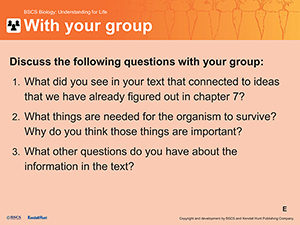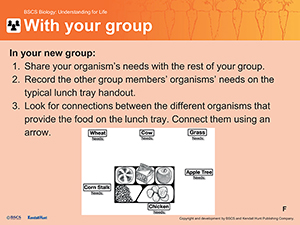CHAPTER 8 • LESSON 6 • GAP ANALYSIS
Where do foods come from and does that affect how many resources they require to produce?
PURPOSE | Identify limitations in our understanding and motivate the need for new investigations and evidence.

TIME
Two 50-minute class periods
PREVIOUS LESSON | We developed a model to figure out how all the ideas from chapter 7 connect with each other to explain how a variety of eating patterns provide all our bodies’ requirements for food. This left us wondering: Where does our food come from and what resources are needed to produce the organisms that supply our food?
THIS LESSON | We figure out that some foods come from animals while others come from plants but all require resources like land, which is limited. We also notice that some animal-based foods require more land than other foods like plants. This leaves us wondering why plant-based foods require less land than animal-based foods.
NEXT LESSON | We will figure out that animal-based foods require more land to produce than plant-based foods because at each trophic level only a small portion of matter that went into the organisms at the lower levels is transferred upward and most is converted into non-food molecules via cellular respiration or lost as waste. This will leave us wondering how producers get all the matter and energy they need to survive.
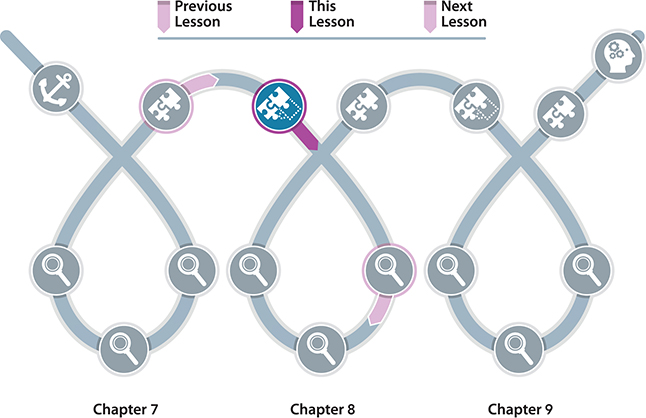
 LESSON LEARNING GOAL
LESSON LEARNING GOAL
Ask questions about the natural resources (matter) and the energy transfers that go into the organisms that become the food on your plate.
Lesson question
Where do foods come from and does that affect how many resources they require to produce?
What students figure out
Consumers get their matter and energy from other organisms.
Humans are consumers.
Plants don’t get their matter and energy directly from other organisms.
All organisms need natural resources like land and water to survive.
The land to grow food is finite.
Plant-based foods generally require less land than animal-based foods.
What we are not expecting
Where we are not going yet
While we discuss the idea that plants require sunlight, we are not developing ideas about photosynthesis until Lesson 8.
In addition, the need for land/space by all organisms that produce our food is observed as well as that plant-based foods require less land than animal-based foods. Why different land requirements are needed for different organisms will be investigated in the next lesson.
Boundaries
We do not expect students to know all the different organisms that make up each of the different food products. The goal is for students to see that our food is provided from other living things.
Students do not need to memorize definitions for the words habitable or agriculture. Students encounter these words so that they can make sense of the graphs they are analyzing.
Relevant common student ideas
Plants get most of their food from soil through their roots; this is why plants need fertilizer. (Plants get most of their matter from carbon dioxide in the air when they undergo photosynthesis.)
Food serves a different purpose in plants than in animals. (Both plants and animals do similar processes like cellular respiration and biosynthesis.)
Only animals perform cellular respiration; plants do not as they perform photosynthesis. (Both plants and animals do similar processes like cellular respiration and biosynthesis.)
Key literacy and sensemaking strategies
Scientific Reading Annotation Stems
Students use the Scientific Reading Annotation Stem to help them set a purpose from reading the different expert group data sheets. It is assumed that students are familiar with using this strategy; if students need more support, refer back to other lessons in units 1 and 2 to look at scaffolds to help students.
I2 Strategy
Students have used the I2 strategy several times across these units. It is assumed that students are familiar with using this strategy; if students need more support refer back to other lessons in units 1 and 2 to look at scaffolds to help students.
ASSESSMENT
Formative Assessment: Graphs
Listen to group conversations as students discuss the patterns they recorded on their Students Sheet 3.6.A: Typical school lunch tray and how it relates to the question: “Where do the organisms that provide our food get their matter and energy?” Listen to group conversation as students discuss the patterns they recorded on their Students Sheet 3.6.A and how it relates to the question: “Where do the organisms that provide our food get their matter and energy?” Look for students to connect these ideas from the organisms from the lunch tray with the ideas they figured out in chapter 7. Students should identify that similar organisms probably do similar processes and how those processes connect to the matter and energy story the class described in chapter 7.
 GAP ANALYSIS LESSON SNAPSHOT
GAP ANALYSIS LESSON SNAPSHOT
Lesson 6: Where do foods come from and does that affect how many resources they require to produce?
BIG IDEA | Some foods come from animals and others from plants but all require resources like land and water to live and grow. While there is not enough land on Earth to support current dietary recommendations by US authorities, plant-based foods require fewer resources than most animal-based foods.
Routine |
Part |
Time |
Summary |
Slide |
Materials |
|
1 |
5 min |
Reflect on the Class Consensus Model to see how it connects where food comes from. Have students return to the Class Consensus Model and look at how humans get matter and energy from food, and then make predictions about how our food gets its matter and energy. Purpose: to help students reflect on what they figured out from the last chapter and realize that they need to understand where their food is getting its matter and energy from. |
A–B |
Class Consensus Model from chapter 7 Science notebooks |
|
2 |
10 min |
Introduce a typical school lunch tray. Students will look at a typical lunch tray and think about where the food on the tray comes from. Students decide that they need to map out on the lunch tray where these organisms are getting their matter and energy. Purpose: to provide a common tray of food from a school lunch that students can relate to seeing and to help them begin to think about the organisms that provide the food on the tray. |
C–D |
|
3 |
10 min |
Read articles about what different organisms need to survive. Students work together in expert groups to read and annotate the articles about their assigned organisms to better understand those organisms’ needs. Purpose: to provide students some background knowledge about their assigned organisms so that they can communicate the needs of those different organisms to the rest of their group. |
E–F |
||
4 |
12 min |
Share, discuss, and record the needs of different organisms represented from the lunch tray. Students work in different groups composed of one person from each of the different organism groups in order to map out the different needs of organisms. Students then work together to look for connections between organisms. Purpose: to have students begin to see connections between the different organisms. |
G |
Student Sheet 3.6.A: Typical School Lunch Tray Color pencils |
|
5 |
13 min |
Discuss and look for patterns between the different organisms’ needs. Students look at the needs of different organisms to see if they have similar needs. Students notice that humans and animals have similar needs. Students also notice that all the organisms need water and land. Purpose: to help students realize that humans and other animals are consumers. To highlight that all organisms need natural resources like water and land in order to survive. |
H |
Student Sheet 3.6.A: Typical School Lunch Tray Class Consensus Model from chapter 7 |
|
Suggested class period break End of Day 1 |
|||||
|
6 |
10 min |
Reflect on several perspectives. Students consider and discuss how the typical lunch tray and the articles view the organisms that make up the food. Students watch an interview providing an Indigenous perspective on the question “What is food?”. Students consider other perspectives about natural resource use and its impact on food. Purpose: to get students to realize that items offered at a school lunch are design choices that have been made by people from specific perspectives. Students also consider what other perspectives might be missing from the design of the typical lunch tray. |
I–J |
Student Sheet 3.6.A: Typical School Lunch Tray Student Sheets 3.6.B–G (food item data sheets) Science notebooks |
7 |
10 min |
Read an article about how there is not enough land. Students read and discuss an article about how there is not enough land currently to feed the entire population meeting everyone’s nutritional requirements. Purpose: to introduce that the natural resource land is finite. |
K |
Student Sheet 3.6.H: Can We Grow Enough Food for Everyone to Eat a Healthy Diet? |
|
8 |
13 min |
Analyze graphs about land use. Students annotate and discuss with a partner two graphs about how Earth is being used to grow and produce food. Purpose: to help students make sense of how the land in the world is currently used. |
L–M |
Student Sheet 3.6.I: Graphs for Understanding Land Use Apple Knife Cutting board |
|
|
9 |
12 min |
Return to add natural resources and specifically land use questions to our Driving Question Board. Students come back to the DQB to see what questions they had about natural resources and land use. They add new questions about land use and how they affect the food that ends up on our plate. Purpose: to capture our questions and set our purpose for what we need to investigate in this chapter. |
N |
Driving Question Board Markers Sticky notes |
|
10 |
5 min |
Reflect on the learning in this lesson and consider how observing things at a smaller scale helped answer questions at a larger scale. Students reflect in this lesson on how they first looked at an individual plate of food and how it helped them connect and understand the global issue of running out of land. Students then reflect on why different organisms have different land requirements. Purpose: to help motivate and prepare students for the work they will do in the next lesson. |
O |
Science notebooks |
Suggested class period break End of Day 2 |
|||||
LESSON MATERIALS
Per student
Sticky notes
Fine-point markers
Student Sheets 3.6.H: Can We Grow Enough Food for Everyone to Eat a Healthy Diet?
Per class
Computer with projector
Markers
Apple
Knife
Cutting board
Per group
1 copy each of Student Sheet 3.6.B-3.6.G data sheets per student for each of the different corresponding expert groups.
Preparation
Clear a space in your classroom for students to display chart papers.
Make 1 copy per student of:
Make 1 copy each of Student Sheet 3.6.B–3.6.G per student for each of the different corresponding expert groups.
Test “What is food?” video to make sure that it plays properly.
ADDITIONAL CONTENT BACKGROUND FOR THE TEACHER
In this lesson students start to consider what perspectives have been included and excluded from decision-making about food systems and the organisms that provide food for humans. The goal is to help students realize that while we can use science to make sense of and understand the impacts of our food system on humans and the environment, when we start to consider decision- making and societal issues, we also need to consider cultural and social factors.
 NAVIGATE
NAVIGATE
PURPOSE | To maintain coherence and continuity
Students prepare science notebooks for class.
Students should turn to a new page in their science notebooks and write the heading that includes the date and “Lesson 6.”
Students reflect individually about what they have figured out about how they get the matter and energy they need to live.
Display Slide A. Have students reflect on chapter 7 by answering the questions on the slide in their science notebooks.
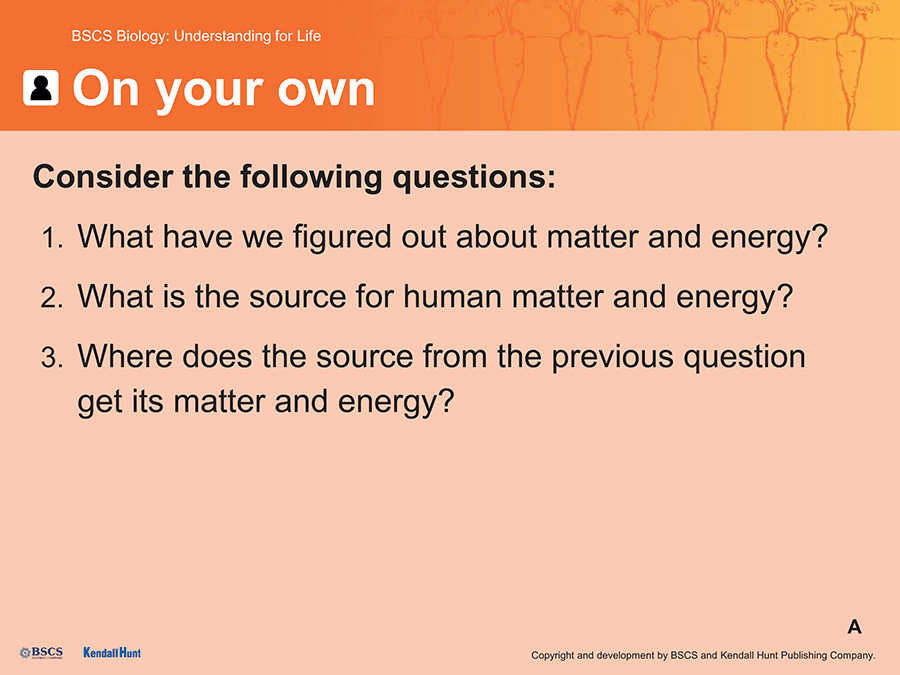
Students discuss and share what they have figured out about how humans get the matter and energy they need to live.
Display Slide B. Have students share what whey individually reflected on in their science notebooks about what they figured out in chapter 7. Then lead students to wonder where the organisms that provide our food get their matter and energy.
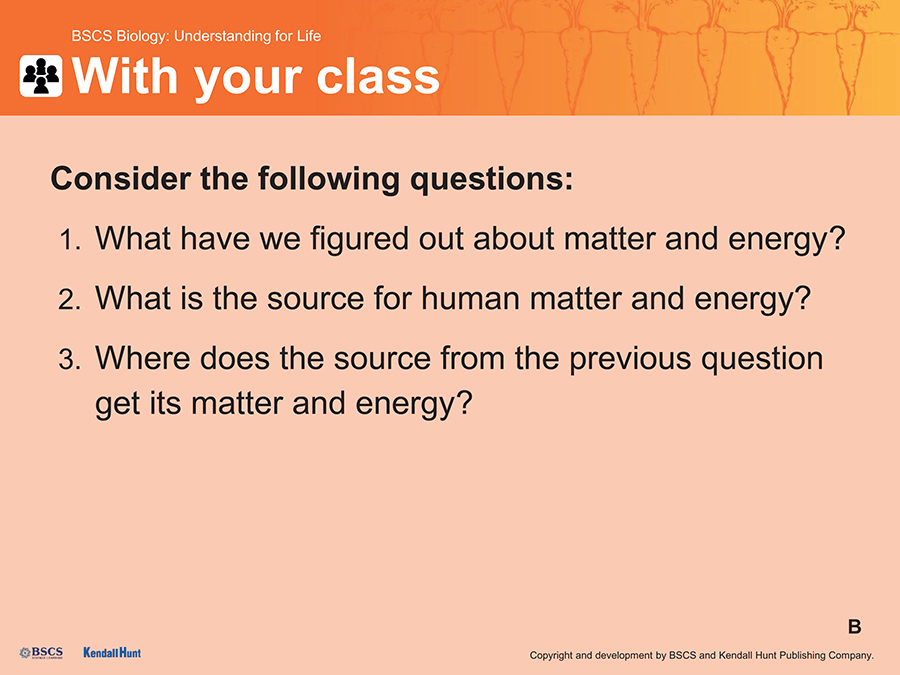
| Suggested prompts | Listen for student responses such as |
|---|---|
| What have we figured out about matter and energy? | The matter comes from the atoms in our food whereas the energy is a characteristic that changes as chemical reactions occur inside the body. |
| What is the source for human matter and energy? | We get our matter and energy from eating food. |
| Where does food get its matter and energy? | Our food comes from other organisms. They get their matter and energy from what they consume. |
Suggest to students that in order to help people meet their nutritional needs we need to understand how the organisms that provide food are getting their nutrition.
 DEFINE GAPS
DEFINE GAPS
PURPOSE | To motivate further investigation
Students observe a typical school lunch tray.
Display Slide C. Introduce the typical lunch tray to students. Let students know that these foods were chosen because these foods are familiar to students everywhere since they are served in lunchrooms across the United States. Allow students to identify the organisms that provide each of the different foods represented on the food tray. Then facilitate the following discussion.
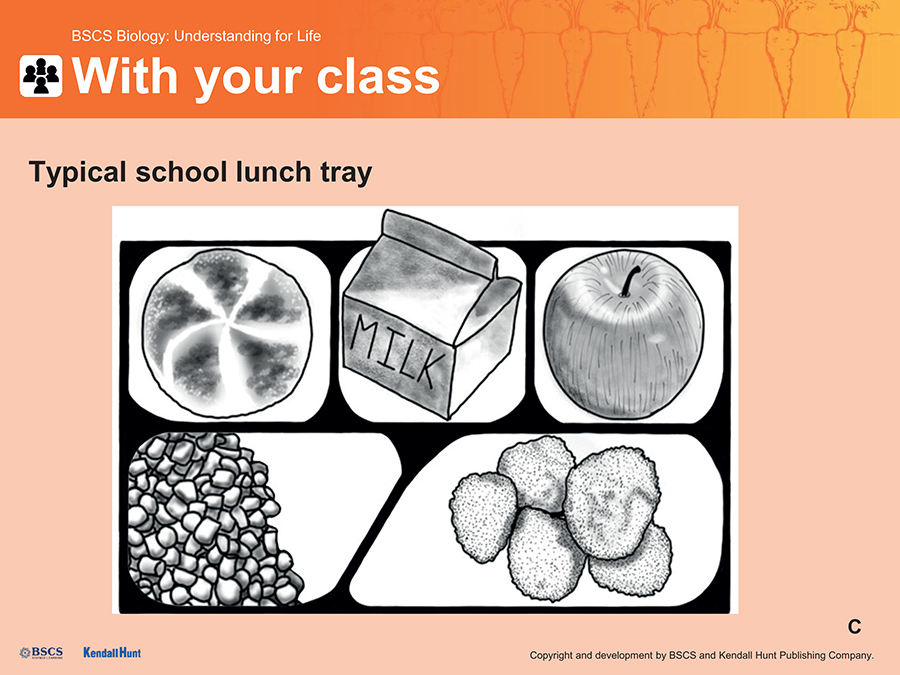
| Suggested prompts | Listen for student responses such as |
|---|---|
| What organisms provide each of the foods found on the typical lunch tray? |
|
| Where do the organisms that provided the food on this lunch tray get their matter and energy? |
|
| Do all organisms get their matter and energy the same way? Explain. | No, each organism has different needs. |
| How could we figure out exactly where each of the organisms that provided these foods got their matter and energy? | We could do some research looking into each of the different organisms to see how they got their matter and energy. |
Attending to Student Ideas
The main goal of this discussion is for students to identify the main organisms that provide the foods on the typical food trays. Students may notice that more than one organism provided ingredients for some of the foods (like eggs and butter in rolls). While these are great observations and can be noted, it is not important here to explore all the minor ingredient organisms that are involved in producing the food on the tray.
Students discuss how grass might connect to the typical lunch tray.
Suggest to students that while some of these foods have multiple organisms that contribute to a single food item on the tray, the class will focus on one main organism that provides the main ingredient for each of the different food items. Remind students that if the class can identify how this organism gets its matter and energy, then we can explain more generally how the food we consume gets its matter and energy. Pass out Student Sheet 3.6.A: Typical school lunch tray. Display Slide D. Note to students that they will examine information about what each organism needs to survive that will help identify where other organisms get their matter and energy. Point out to students that grass is an additional organism in the information. Facilitate the following short discussion with the class.
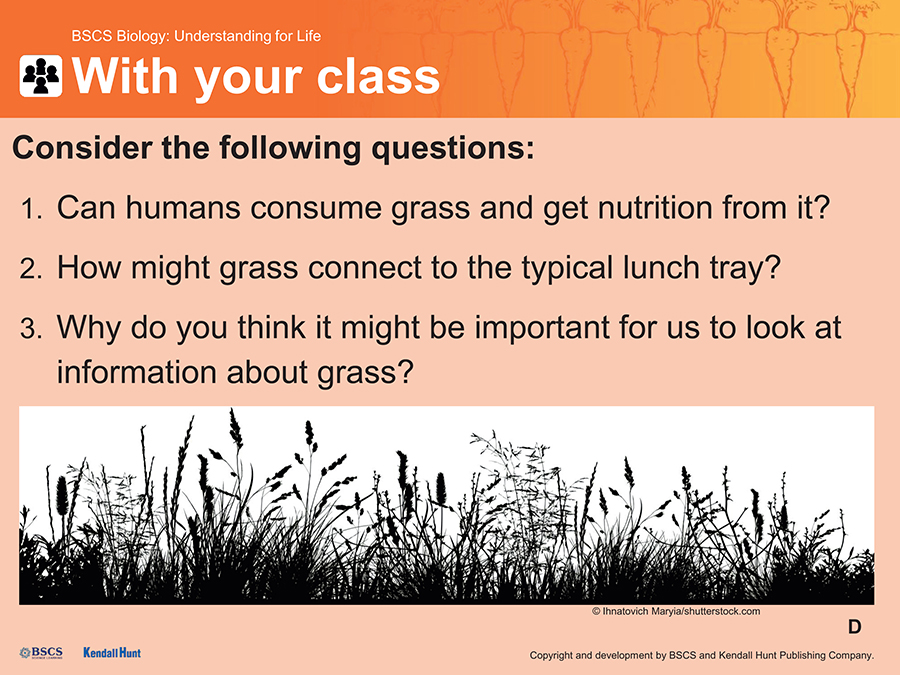
| Suggested prompts | Listen for student responses such as |
|---|---|
| Grass was not on the typical lunch tray. Can humans consume grass and get nutrition from it? | No, we can’t digest grass! |
| How might grass connect to the typical lunch tray? | Other organisms that provide food on our lunch tray consume grass, such as cows. |
| Why do you think it might be important for us to look at information about grass? | Since we want to track matter and energy we need to see what other organisms need in order to better keep track of matter and energy flow. |
Students work in groups annotating the text about their organism that connects to the typical lunch tray.
Arrange students in six expert groups. Note that each group will examine one of the organisms that provided the food on the lunch tray. Distribute the appropriate Student Sheets 3.6.B, 3.6.C, 3.6.D, 3.6.E, 3.6.F, 3.6.G to each student in the corresponding expert group.
Co-construct the Scientific Purpose for reading to gather information about what the organism needs to survive. Have students use the Science Reading Annotation Stems to help them annotate the reading.
Invite students to first read the text individually. When all members of the group have finished reading and annotating, they should share their annotations with the rest of the group and come to consensus about what their assigned organism needs to survive. Display Slide E. As groups discuss the information in their text, circulate through the room, supporting groups in their understanding of the text and encouraging them to make connections to prior learning. Groups should consider the following questions as they share their annotations. Students should record what their organisms need on Student Sheet 3.6.A: Typical school lunch tray.

Questions:
What did you see in your text that connected to ideas that we have already figured out in chapter 7?
What things are needed for the organism to survive? Why do you think those things are important?
What other questions do you have about the information in the text?
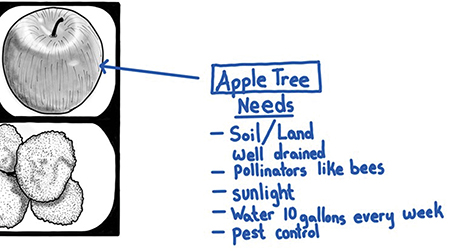
Sample student work, recording what each organism needs on Student Sheet 3.6.A.
Attending to Student Ideas
Students may notice that they may not need all of the information in the text in order to create their list of what their organism needs. While this is true for this activity it is helpful to note that this text will be used multiple times throughout the lesson. Each time students look at this text they will be looking at different information. This text also provides students who may have limited knowledge about these organisms an opportunity to gain a deeper understanding about their assigned organisms. This way these students can share and discuss the organisms with others in a meaningful way.
Students share the needs of their organisms with a new group.
Once groups have discussed the needs of their organisms, draw the class back together. Display Slide F. Inform students that they will share their information with others in the class.

Have students in each expert group number off so that you can form new groups with at least one representative from each of the six expert groups. Have students gather with their new group in different areas of the room. Once groups are established, they should share the needs of their organism with the rest of the group. As information is shared, students should work together to make sure that everyone in the group has all the information recorded on their copy of Student Sheet 3.6.A: Typical school lunch tray.
Students look for connections between the different organisms that provide the food on the lunch tray.
Have students work together in their groups to identify patterns in the needs of the organisms that provided the food for the lunch tray. Instruct students to draw arrows to represent connections between organisms. Provide an example for the class: “In addition to humans, chickens also eat corn, so I’ll draw an arrow from the corn to the chicken to show that the chicken gets matter and energy from the corn.”
Students look for patterns between the different organisms on the lunch tray.
Display Slide G. Pass out colored pencils to each group. Have students work together to identify and highlight patterns in the common needs shared among
All organisms
Animals (consumers)
Plants (producers)
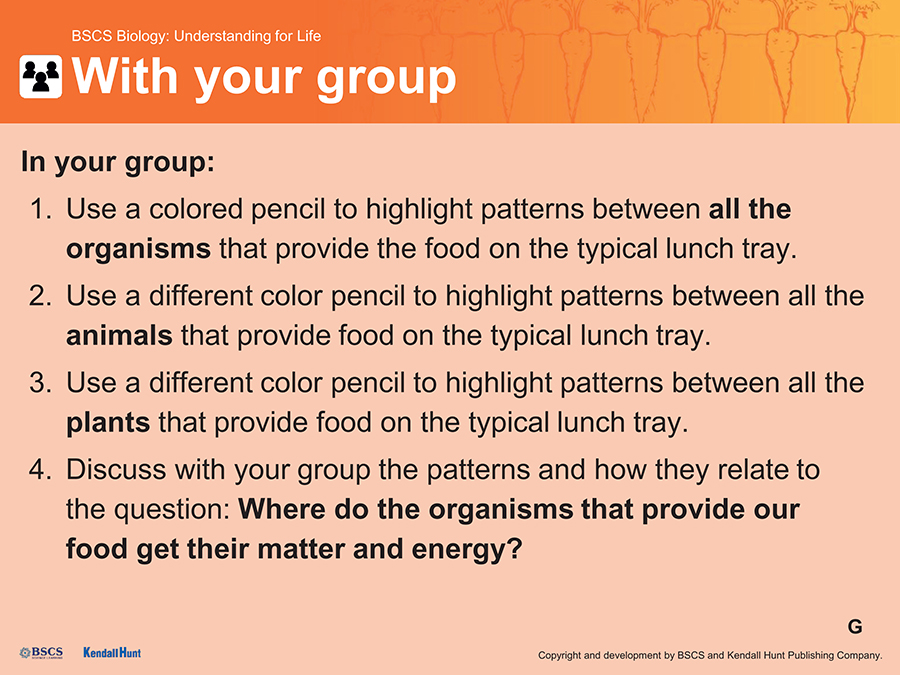
As students work, circulate among groups, noting the patterns they are observing. If needed, use a gallery walk, have groups report to the class, or send a student from each group to observe the patterns identified by other groups.
Invite groups to discuss how the patterns provide information that will help answer the question, “Where do the organisms that provide our food get their matter and energy?” Groups should add these ideas to their sheets.
Formative Assessment Opportunity
Listen to group conversations as students discuss the patterns they recorded on their Students Sheet 3.6.A Typical school lunch tray and how it relates to the question: “Where do the organisms that provide our food get their matter and energy?” Look for students to connect these ideas from the organisms from the lunch tray with the ideas they figured out in chapter 7. Students should identify that similar organisms probably do similar processes. While students may name different processes like photosynthesis or cellular respiration, ask them to say more about how those processes connect to the matter and energy story the class described in chapter 7.
Students discuss the patterns they observed about the organisms that made up the food on the lunch tray.
Display Slide H. Invite groups to share the patterns of common needs they identified with the class and how those patterns help answer the question, “Where do the organisms that provide our food get their matter and energy?”
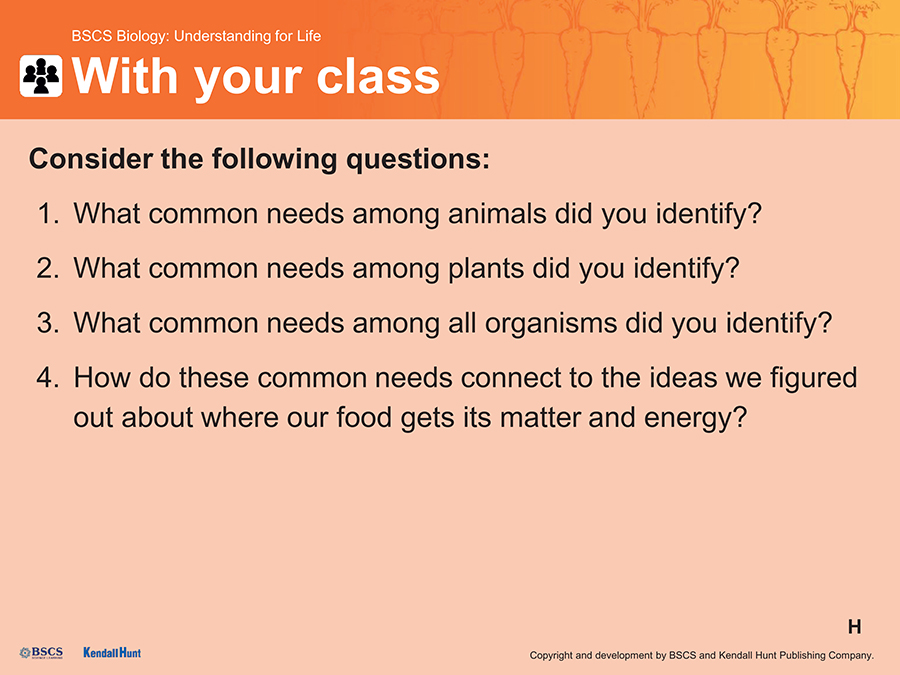
| Suggested prompts | Listen for student responses such as |
|---|---|
| What common needs among animals did you identify? | All the animals had arrows going to them. It shows they eat other organisms in order to get their food/nutrition. |
| What common needs among plants did you identify? | All plants need sunlight; they use the energy from sunlight to make carbohydrates for the plant. |
| Based on what we figured out in chapter 7 what type of organism do you think humans are most similar to? | Humans are more similar to animals because they have to eat other organisms in order to get their food and nutrition. |
| Do you think animals, like humans, also do similar processes like cellular respiration and biosynthesis? Explain. | Yes, because animals have similar inputs that we do and also are eating for the same reasons in order to grow and have energy. |
Summarize that in science they call organisms that eat other organisms, like animals and humans, consumers. Organisms like plants they call producers. Update the Class Consensus Model from chapter 7 to represent that this model is not just for humans but can apply to other consumers, too. Add consumers and producers along with their definitions to the Word Wall as well. Suggest that we will continue to refer to animals and humans as consumers and plants as producers throughout the rest of the chapter. Then continue facilitating the rest of the discussion.
| Suggested prompts | Listen for student responses such as |
|---|---|
| What common needs among all organisms did you identify? | All of the organisms need water and land. |
| How do these common needs connect to the ideas we figured out about where our food gets its matter and energy? |
|
Developing the Crosscutting Concepts: Energy and Matter
Students will be able to make connections between the different animals (systems) and connect them to what the class figured out in humans (systems) from the Class Consensus Model in chapter 7. Students will discuss how similar systems of matter and energy flow inside human systems like cellular respiration and biosynthesis are also occurring in other consumers.
Extension Opportunity
Students may wonder if all foods really come from living things. The food items chosen for the typical lunch tray have easy connections to living things, but what about food products that are heavily processed? What about food items like cheese puffs or fruit snacks? Are these also really made from living things? If time allows, have students do their own investigation into some of these food products by doing some online research to determine if their ingredients also come from other living things.

SUGGESTED CLASS PERIOD BREAK
End of Day 1
 DEFINE GAPS
DEFINE GAPS
PURPOSE | To motivate further investigation
Students reflect on the perspectives that create food system decisions like school lunches.
Celebrate with students that the class figured out a lot of ideas about how food provides humans with the nutrition they need by looking at the typical lunch tray and the organisms that provide the food on it. Suggest to students that while the class looked at a “typical lunch tray” that might be found anywhere in the United States, it is a lunch that has been designed by someone(s) with decision-making power. Display Slide I. Have students considered whose ideas and perspectives go into these decisions? Allow students to start two separate lists in their science notebooks:
Whose ideas and perspectives typically make food system decisions (like school lunches)?
Whose ideas and perspectives are typically missing from food system decisions (like school lunches)?
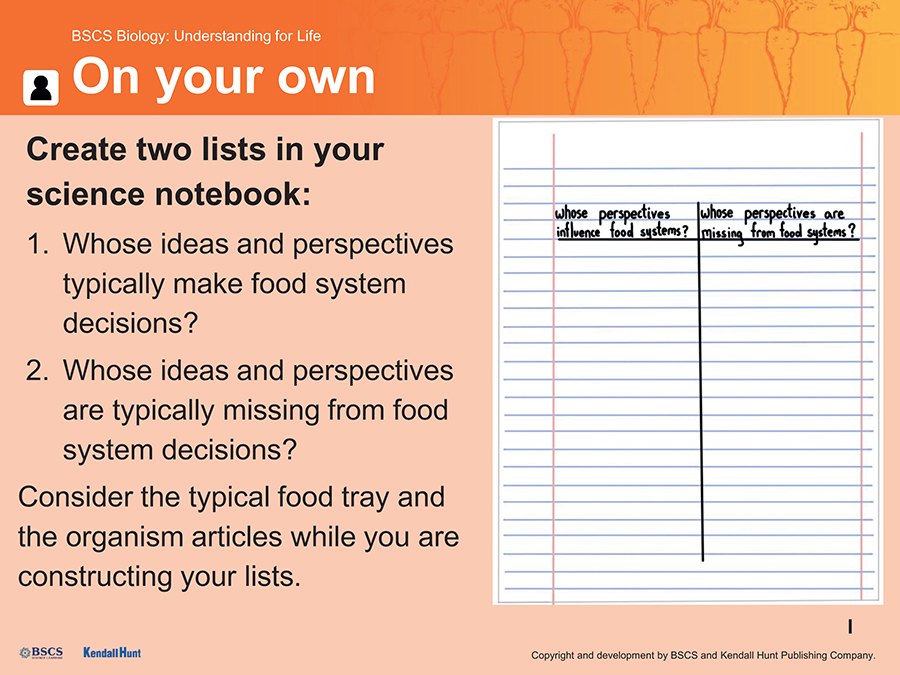
Allow for students to individually take some time recording some of their initial thoughts for each of these lists. After a few minutes have students return to the articles about their organism to consider what perspective these articles have about the organisms that provide food for humans. Have students also record any additional perspectives that influence food system decisions from these articles and add them to their lists.
Students discuss perspectives that are present in creating food system decisions and those that are missing.
Bring the class back together to discuss their lists and why having different perspectives are important for decision-making. Facilitate the following discussion.
| Suggested prompts | Listen for student responses such as |
|---|---|
| Whose perspectives influence food system decisions? What evidence do we have of this? |
|
| Whose perspectives seem to be missing from food system decisions? |
|
| How do the articles view organisms that provide us with food? | They view organisms as a “commodity” or “resource” that is used to provide us with the nutrition we need. |
| Do you think all people view organisms this way? Explain. | No, there are people who look at organisms as living things, not just how they benefit humans. |
| Why is it important to consider other perspectives when making decisions? | Hearing other perspectives helps us gain more information so that we can make better informed decisions that benefit more people. |
Attending to Equity
Taking stock of the perspectives that went into current food system decisions and acknowledging other perspectives that are missing from the decision-making can serve multiple purposes. (1) It communicates that when working together it is important to consider everyone’s ideas. (2) It helps students feel like they belong in the science classroom by acknowledging that family and community knowledge is productive for science and engineering. (3) It helps build empathy for students to listen to and take on other perspectives that might be different from their own lived experience.
Introduce and watch a video on Indigenous perspectives.
Remind the class that when looking closer at food systems and considering ways to improve them, the class is really considering the food system in the context of the United States (US). State that while the example food tray represents what might be found anywhere in the US, it does not represent all different perspectives of people who live in the US. Suggest to students that looking at other perspectives about food and the organisms who make up the food that ends up on plates will help expand the class’s knowledge about food systems.
Introduce to students that in this unit we will watch several videos from an Indigenous perspective to help provide the class with other perspectives about food systems in the US. In these videos we will hear stories about food, the organisms that make up food, the food system itself, and its impact on individuals as well as their communities. Inform students that while each of these individuals are Indigenous they are speaking as individuals and do not speak on behalf of all Indigenous peoples or the nations they are a part of. Oral storytelling is a rich tradition of many Indigenous communities; it is for this reason they preferred to provide this information to students by video rather than article.
Have students make a notice and wonder chart in their science notebooks to capture ideas they see and hear from watching the video.
Inform students that this particular video is an interview with Grace Tracy, a Diné (Navajo) knowledge keeper; she will be speaking in the Navajo language.
Pass out a copy of Student Sheet 3.6.J: Video Transcript: What Is Food? to each student so they can follow along, if helpful. Play the video: What Is Food?
Attending to Equity
To support the unique culture and perspectives that each Indigenous student brings into your classroom you may want to emphasize that Indigenous is a broad term comprising over 574 federally recognized American Indian and Alaska Native tribes (nations) and more than 200 that are unrecognized; each one is uniquely connected to their own land base, with their own language, culture, and way of life.
Be mindful also of not asking (or allowing peers to ask) Indigenous students to speak “for” their nation or culture either. You may welcome any volunteered contributions or connections students may make to this speaker, but avoid asking individual students to speak on the topic on the basis of their identity.
Students connect and discuss the Indigenous perspective video and consider how it expands the class’s ideas about food and organisms that provide it.
Display Slide J. Give students a minute to reflect on their notice and wonder chart, then facilitate the following discussion.
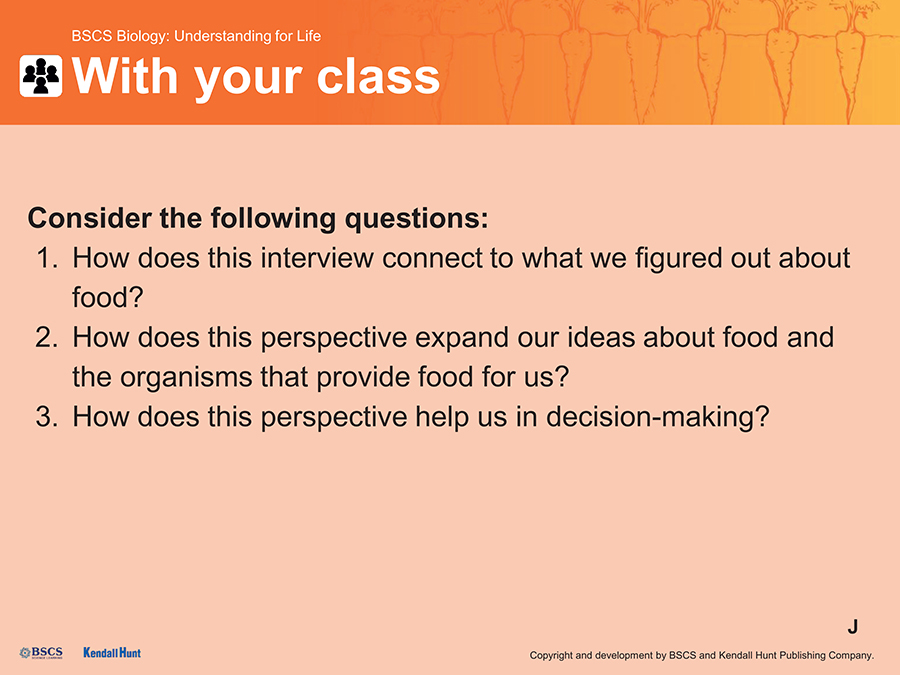
| Suggested prompts | Listen for student responses such as |
|---|---|
| How does this interview connect to what we figured out about food? |
|
| How does this perspective expand our ideas about food and the organisms that provide food for us? | We are living together with animals, birds, and insects. We share our food with them and they share their food with us. |
| How does this perspective help us in decision-making? | It helps us see that we should be concerned not only with what we can get from organisms but also how we can give back to them as well. |
Students capture the new question.
Summarize student ideas that there are many different perspectives about food, the organisms that make up our food, and the resources needed. Remind students that back in the Anchor Lesson (Lesson 1) activity when students were designing their plate of food, one of the criteria was considering how natural resources were being used to produce different foods. How do natural resources like land and water impact the organisms that make up our food? And more generally: Where does our food come from and does that affect how many resources they require to produce? Pause to have students record this lesson question (or similar question, using students’ own words) on the page they started for Lesson 6 in their science notebooks.
Read an article about whether we have enough land.
Suggest to students that now that we know what different resources organisms need we should look at the perspective of natural resource use to understand why people are concerned about this. Pass out Student Sheet 3.6.H: Can we grow enough food for everyone to eat a healthy diet? Have students work in pairs annotating the text to understand why people are concerned about how we are using our natural resources.
Discuss the article about whether we have enough land.
Display Slide K. Bring the class back together to discuss the article and how it can explain why people are concerned about our use of natural resources.
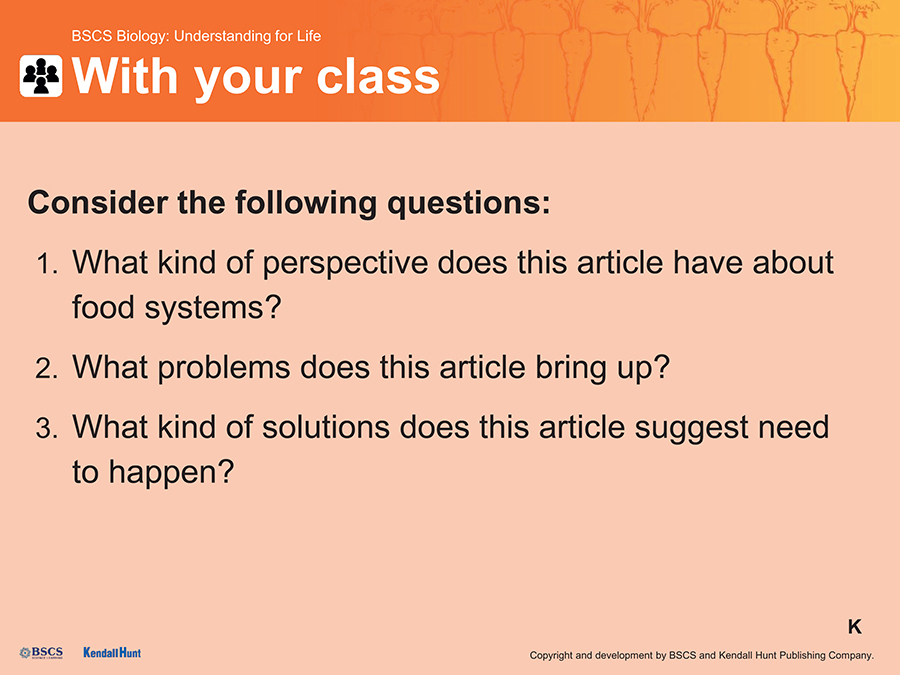
| Suggested prompts | Listen for student responses such as |
|---|---|
| What kind of perspective does this article have about food systems? |
|
| What problems does this article bring up? |
|
| What kinds of solutions does this article suggest need to happen? |
|
Students analyze graphs about land use.
Suggest to students that the class needs to look closer at some data about how we are currently using the natural resource land to help us better understand the problem. Display Slide L. Distribute Student Sheet 3.6.I: Graphs for understanding land use. Have students work with a partner to make sense about how these graphs connect with the concerns from the article by annotating the graphs using the I2 strategy.
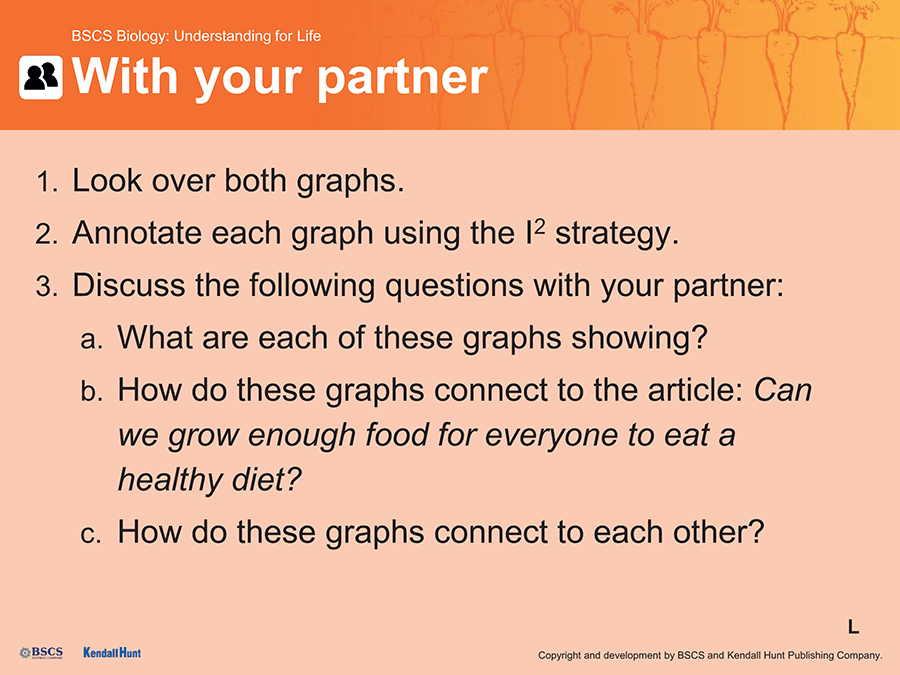
Discuss graphs about land use with the aid of an apple.
Display Slide M. Bring students back together. Suggest to students that sometimes it can be difficult to picture some of this data because it is at a large global scale. Therefore, in science we often turn to models to help us visualize data. Display an apple. Consider the following framing: “Since we can see the whole world at once, let’s consider using this apple to represent Earth to help us better understand how our food choices impact land use.” Facilitate the following discussion.
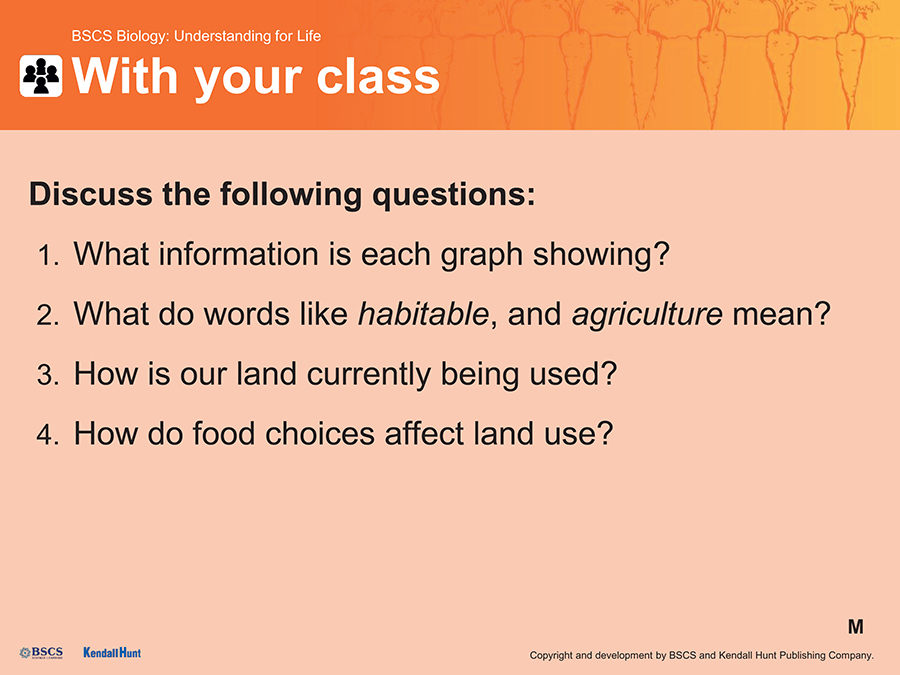
| Suggested prompts | Listen for student responses such as |
|---|---|
| What type of information is graph 1 showing? | The graph shows the different ways and percentage of Earth on how it is being “used.” |
| In what ways could an apple be useful in modeling the data from graph 1? |
|
| According to the data, if I were to cut this apple as if it were Earth, what is most of the earth surface? | The ocean because it makes up 71% of Earth’s surface. |
Take the apple and cut approximately ⅓ of the apple to represent the land and place the other ⅔ of the apple to the side, reminding students that it represents the surface of Earth covered by ocean. Now only holding the ⅓ remaining apple that represents land asks students the following questions.
| Suggested prompts | Listen for student responses such as |
|---|---|
| Why is it important for land to be habitable? | Because if land is not habitable that means it can’t support life. |
| How much of the land is habitable? | 71% of the remaining land |
Take the piece of apple that represents land and cut approximately ⅓ off telling students that it represents the ⅓ of land that is not habitable. Continue to hold the remaining ⅔ of that piece and ask students the following questions.
| Suggested prompts | Listen for student responses such as |
|---|---|
| What is agriculture? | Land that is used for the production of food. |
| How much of the habitable land is used for agriculture? | About 50% of the habitable land is used for agriculture. |
Take the remaining piece of apple that represents habitable land and cut it in half. Set half of the apple aside telling students that this land is not being used for agriculture. Continue to hold the piece that represents the land used for agriculture and ask students the following questions:
| Suggested prompts | Listen for student responses such as |
|---|---|
| How does graph 1 show how land is used for agriculture? | It shows that it is being used to produce meat-based products and plant-based products. |
| Which is currently using more land: meat-based products or plant-based products? | More land is being used to produce livestock than is being used to produce crops. |
Take the remaining piece of apple that represents habitable land and cut ⅓ off. Hold the ⅔ apple piece in one hand and say that this piece represents the land on earth that is currently used to raise livestocks used for meat products. Hold the ⅓ piece of apple and say that it represents the land on earth that is currently used to raise crops for plant-based foods. Then ask students the following questions.
| Suggested prompts | Listen for student responses such as |
|---|---|
| According to graph 1 do people eat more meat products or plant products? | Looking at the calories, more people are eating plant-based products. |
| How does graph 1 show that food choices affect land use? | If we ate even less meat we could significantly change the amount of land needed for agriculture. |
Transition students to talk about graph 2, and how it connects to what the class has figured out from looking at graph 1. Continue to facilitate the following discussion.
| Suggested prompts | Listen for student responses such as |
|---|---|
| What type of information is graph 2 showing? | This graph shows the amount of land needed for different types of food products that provide humans protein. |
| Do all meat-based products require the same amount of land? Explain. | No, some meat-based products like lamb or mutton require a lot of land, whereas eggs require very little land. |
| How does graph 2 connect to graph 1? | It shows us that meat-based products overall need more land to produce protein and that can explain why more land is used in agriculture for meat-based foods. |
| How does graph 2 show that food choices affect land use? |
|
Attending to Student Ideas
As the class is thinking about food systems and providing all people with the nutritional requirements they need, students may wonder what will happen to the apple after the class is over. Will it be thrown out? Should it be composted? Should it be saved to eat later? Allow the class to think about this dilemma, and come up with a solution as a class.
 ASK AND ORGANIZE QUESTIONS
ASK AND ORGANIZE QUESTIONS
PURPOSE | To set the mission based on student questions
Students return to the Driving Question Board and reflect on questions about natural resources and specifically about land.
Reflect with students looking back at all the things we did in this lesson in regard to thinking about how matter and energy flow through the organisms that make up our food and how much land they require. Refer to the DQB and point out that there are a lot of different questions we have about natural resources, but suggest that it seems the class has a lot of questions about the specific natural resource, land. Remind students that we also seem to have some questions about different views and perspectives about food and natural resources.Display Slide N. Suggest that we look at what questions we have about natural resources, specifically land, and what new questions we need to add to our DQB.
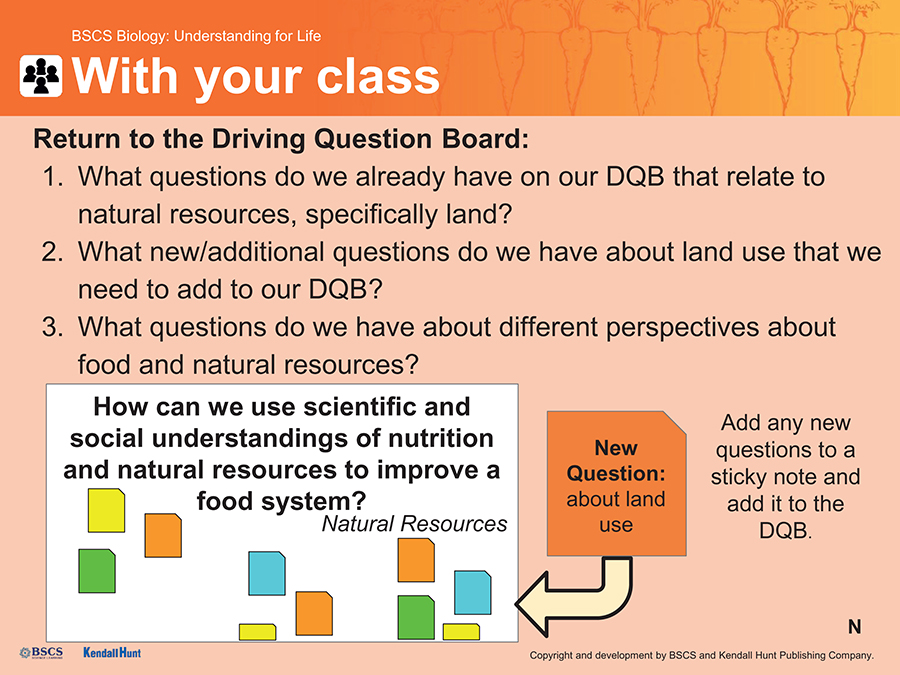
| Suggested prompts | Listen for student responses such as |
|---|---|
| What questions do we already have on our DQB that relate to natural resources, specifically land? |
|
| What new/additional questions do we have about land use that we need to add to our DQB? |
|
| What questions do we have about different perspectives about food and natural resources? |
|
Have students look over and discuss what questions they added on the DQB that might need to be answered by looking beyond just the science. Then mark these questions with a star so that the class can consider them in chapter 9 when they start designing solutions from an engineering context.
Developing the Practices: Asking Questions
Each time students return to revise or add to the DQB they should be gaining confidence and proficiency with asking questions that arise from careful observation of phenomena to clarify and/or seek additional information.
 NAVIGATE
NAVIGATE
PURPOSE | To maintain coherence and continuity
Students reflect on how observing things at a smaller scale helped answer questions at a larger scale.
Display Slide O. Remind students that we started this lesson analyzing an individual typical school lunch tray and ended this lesson discussing land used at a global scale. Remind students that we also noticed that less meat is consumed in the world than plants, yet humans are using more land to produce meat-based food products than plant-based food products. Have students individually respond to the following questions in their science notebooks.
How did looking at an individual lunch tray of food get us to look at global land use?
How does understanding ideas at a smaller scale help us make sense of ideas at a larger scale? Give an example from this unit.
And now we’re left wondering: Why do animal-based food products require more land than plant-based food products?
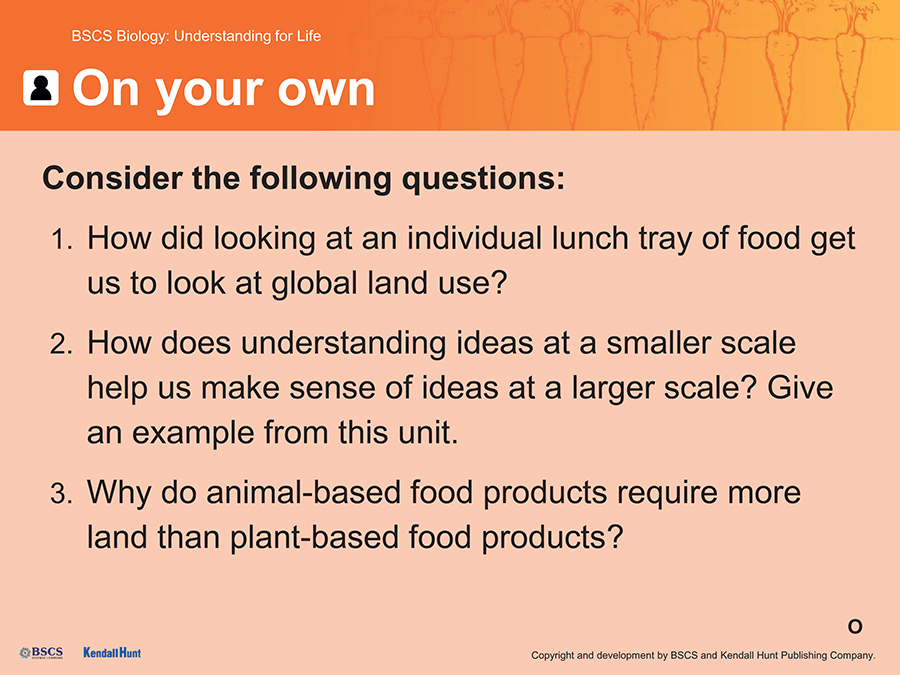

SUGGESTED CLASS PERIOD BREAK
End of Day 2
REFERENCES
Dockrill, Peter. “There Is Not Enough Land on Earth to Support the Diet Recommended by Authorities.” ScienceAlert, August 14, 2018. https://www.sciencealert.com/not-enough-land-earth-support-dietusda-recommends-guidelines-environment-ecosystem-health. (Student Sheet 3.6.H)
Ritchie, Hannah, and Max Roser. “Environmental Impacts of Food Production.” Our World in Data. 2020. https://ourworldindata.org/environmental-impacts-of-food. (Student Sheet 3.6.I)
“Crops/World Total/Wheat/Area Harvested/2014 (pick list)”. United Nations, Food and Agriculture Organization, Statistics Division (FAOSTAT). 2014. Archived from the original on 6 September 2015. Retrieved 8 December 2016. (Student Sheet 3.6.B)
Shewry, P. and Hey, S., 2015. The contribution of wheat to human diet and health. [online] NCBI, US national Library of Medicine National Institutes of Health. Available at: <https://www.ncbi.nlm.nih.gov/pmc/articles/PMC4998136/> [Accessed 15 October 2021]. (Student Sheet 3.6.B)
Pajević, S., Krstić, B., Stanković, Ž. et al. Photosynthesis of Flag and Second Wheat Leaves During Senescence. CEREAL RESEARCH COMMUNICATIONS 27, 155–162 (1999). https://doi.org/10.1007/BF03543932 (Student Sheet 3.6.B)
Genetic Science Learning Center. “Evolution of Corn.” Learn.Genetics. August 1, 2017. Accessed October 13, 2021. https://learn.genetics.utah.edu/content/evolution/corn/. (Student Sheet 3.6.C)
Linda Campbell Franklin, “Corn,” in Andrew F. Smith (ed.), The Oxford Encyclopedia of Food and Drink in America. 2nd ed. Oxford: Oxford University Press, 2013 (pp. 551–558), p. 553. (Student Sheet 3.6.C)
USDA U.S. Department of Agriculture. 2021. Corn, Sweet, Yellow Raw. [online] Available at: <https://fdc.nal.usda.gov/fdc-app.html#/food-details/169998/nutrients> [Accessed 15 October 2021]. (Student Sheet 3.6.C)
Regenstein, J. M. and Singh, . R. Paul. “Poultry processing.” Encyclopedia Britannica, August 15, 2018. https://www.britannica.com/technology/poultry-processing. (Student Sheet 3.6.D)
BESSEI, W. “Welfare of Broilers: a Review.” World’s Poultry Science Journal 62, no. 3 (2006): 455–66. doi:10.1017/S0043933906001085. (Student Sheet 3.6.D)
National Chicken Council. 2021. National Chicken Council | Broiler Chicken Industry Key Facts 2019. [online] Available at: <https://www.nationalchickencouncil.org/about-the-industry/statistics/broiler-chicken-industry-key-facts/> [Accessed 15 October 2021]. (Student Sheet 3.6.D)
Turner, D., Garcés, L. and Stevenson, P., 2005. The Welfare of Broiler Chickens in the European Union. [ebook] Petersfield: World Farming Trust, p.5. Available at: <https://www.ciwf.org.uk/media/3818904/welfare-of-broilers-in-the-eu.pdf> [Accessed 15 October 2021]. (Student Sheet 3.6.D)
Web.extension.illinois.edu. 2021. Apple Facts—Apples and More—University of Illinois Extension. [online] Available at: <https://web.extension.illinois.edu/apples/facts.cfm> [Accessed 15 October 2021]. (Student Sheet 3.6.E)
Nutritiondata.self.com. 2021. Apples, raw, with skin [Includes USDA commodity food A343] Nutrition Facts & Calories. [online] Available at: <https://nutritiondata.self.com/facts/fruits-and-fruit-juices/1809/2> [Accessed 15 October 2021]. (Student Sheet 3.6.E)
Polomski, Bob; Reighard, Greg. “Apple”. Clemson University. Archived from the original on 28 February 2008. Retrieved 22 January 2008. (Student Sheet 3.6.E)
Vet Student at University of Liverpool, 2015. Life Cycle of Typical Milk Producing Dairy Cow. [Blog] Vet In Training, Available at: <http://vetstudentresearch.blogspot.com/2015/06/life-cycle-and-lactation-cycle-of-dairy.html> [Accessed 15 October 2021]. (Student Sheet 3.6.F)
Moonjan, E., 2019. Why the USDA Wants to Put Whole Milk Back in School Lunches. [online] Pacific Standard. Available at: <https://psmag.com/news/why-the-usda-wants-to-put-whole-milk-back-in-school-lunches> [Accessed 15 October 2021]. (Student Sheet 3.6.F)
Thomas, C., 2021. Drinking water for dairy cattle: Part 1. [online] MSU Extension. Available at: <https://www.canr.msu.edu/news/drinking_water_for_dairy_cattle_part_1> [Accessed 15 October 2021]. (Student Sheet 3.6.F)
Lissbrant, S., Berg, W., Volenec, J., Brouder, S., Joern, B., Cunningham, S. and Johnson, K., 2009. Phosphorus and Potassium Fertilization of Alfalfa. [ebook] West LaFayette: Purdue University. Available at: <https://www.extension.purdue.edu/extmedia/ay/ay-331-w.pdf> [Accessed 15 October 2021]. (Student Sheet 3.6.G)
Britannica, T. Editors of Encyclopaedia. “Alfalfa.” Encyclopedia Britannica, November 17, 2017. https://www.britannica.com/plant/alfalfa. (Student Sheet 3.6.G)







